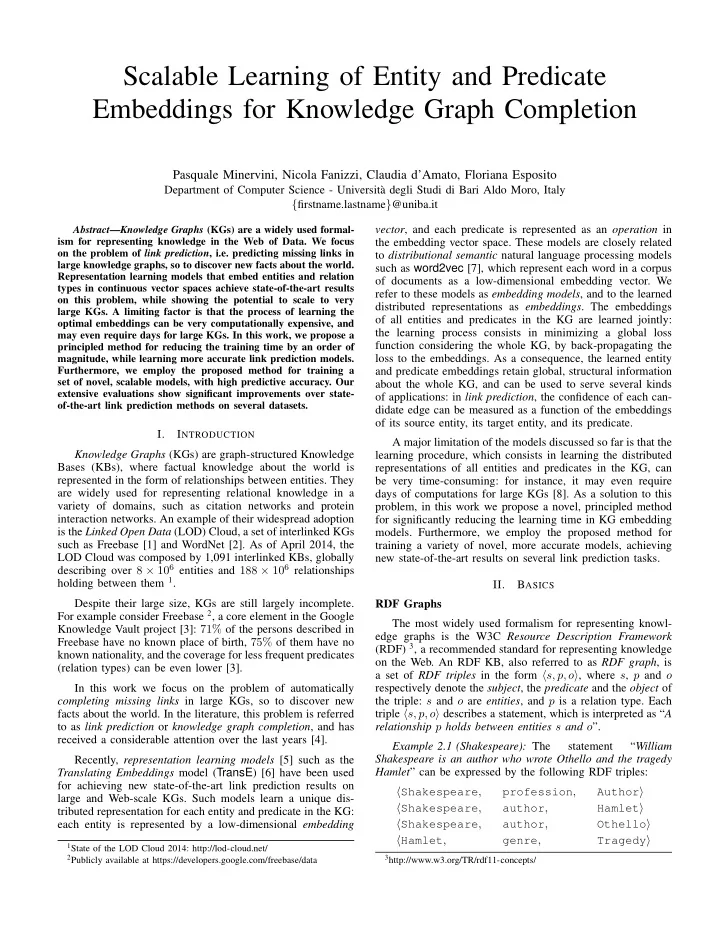

Scalable Learning of Entity and Predicate Embeddings for Knowledge Graph Completion Pasquale Minervini, Nicola Fanizzi, Claudia d’Amato, Floriana Esposito Department of Computer Science - Universit` a degli Studi di Bari Aldo Moro, Italy { firstname.lastname } @uniba.it Abstract — Knowledge Graphs (KGs) are a widely used formal- vector , and each predicate is represented as an operation in ism for representing knowledge in the Web of Data. We focus the embedding vector space. These models are closely related on the problem of link prediction , i.e. predicting missing links in to distributional semantic natural language processing models large knowledge graphs, so to discover new facts about the world. such as word2vec [7], which represent each word in a corpus Representation learning models that embed entities and relation of documents as a low-dimensional embedding vector. We types in continuous vector spaces achieve state-of-the-art results refer to these models as embedding models , and to the learned on this problem, while showing the potential to scale to very distributed representations as embeddings . The embeddings large KGs. A limiting factor is that the process of learning the of all entities and predicates in the KG are learned jointly: optimal embeddings can be very computationally expensive, and the learning process consists in minimizing a global loss may even require days for large KGs. In this work, we propose a function considering the whole KG, by back-propagating the principled method for reducing the training time by an order of loss to the embeddings. As a consequence, the learned entity magnitude, while learning more accurate link prediction models. Furthermore, we employ the proposed method for training a and predicate embeddings retain global, structural information set of novel, scalable models, with high predictive accuracy. Our about the whole KG, and can be used to serve several kinds extensive evaluations show significant improvements over state- of applications: in link prediction , the confidence of each can- of-the-art link prediction methods on several datasets. didate edge can be measured as a function of the embeddings of its source entity, its target entity, and its predicate. I. I NTRODUCTION A major limitation of the models discussed so far is that the Knowledge Graphs (KGs) are graph-structured Knowledge learning procedure, which consists in learning the distributed Bases (KBs), where factual knowledge about the world is representations of all entities and predicates in the KG, can represented in the form of relationships between entities. They be very time-consuming: for instance, it may even require are widely used for representing relational knowledge in a days of computations for large KGs [8]. As a solution to this variety of domains, such as citation networks and protein problem, in this work we propose a novel, principled method interaction networks. An example of their widespread adoption for significantly reducing the learning time in KG embedding is the Linked Open Data (LOD) Cloud, a set of interlinked KGs models. Furthermore, we employ the proposed method for such as Freebase [1] and WordNet [2]. As of April 2014, the training a variety of novel, more accurate models, achieving LOD Cloud was composed by 1,091 interlinked KBs, globally new state-of-the-art results on several link prediction tasks. describing over 8 × 10 6 entities and 188 × 10 6 relationships holding between them 1 . II. B ASICS Despite their large size, KGs are still largely incomplete. RDF Graphs For example consider Freebase 2 , a core element in the Google The most widely used formalism for representing knowl- Knowledge Vault project [3]: 71% of the persons described in edge graphs is the W3C Resource Description Framework Freebase have no known place of birth, 75% of them have no (RDF) 3 , a recommended standard for representing knowledge known nationality, and the coverage for less frequent predicates on the Web. An RDF KB, also referred to as RDF graph , is (relation types) can be even lower [3]. a set of RDF triples in the form � s, p, o � , where s , p and o respectively denote the subject , the predicate and the object of In this work we focus on the problem of automatically the triple: s and o are entities , and p is a relation type. Each completing missing links in large KGs, so to discover new facts about the world. In the literature, this problem is referred triple � s, p, o � describes a statement, which is interpreted as “ A to as link prediction or knowledge graph completion , and has relationship p holds between entities s and o ”. received a considerable attention over the last years [4]. Example 2.1 (Shakespeare): The statement “ William Shakespeare is an author who wrote Othello and the tragedy Recently, representation learning models [5] such as the Translating Embeddings model ( TransE ) [6] have been used Hamlet ” can be expressed by the following RDF triples: for achieving new state-of-the-art link prediction results on � Shakespeare , profession , Author � large and Web-scale KGs. Such models learn a unique dis- � Shakespeare , author , Hamlet � tributed representation for each entity and predicate in the KG: � Shakespeare , author , Othello � each entity is represented by a low-dimensional embedding � Hamlet , genre , Tragedy � 1 State of the LOD Cloud 2014: http://lod-cloud.net/ 2 Publicly available at https://developers.google.com/freebase/data 3 http://www.w3.org/TR/rdf11-concepts/
Recommend
More recommend